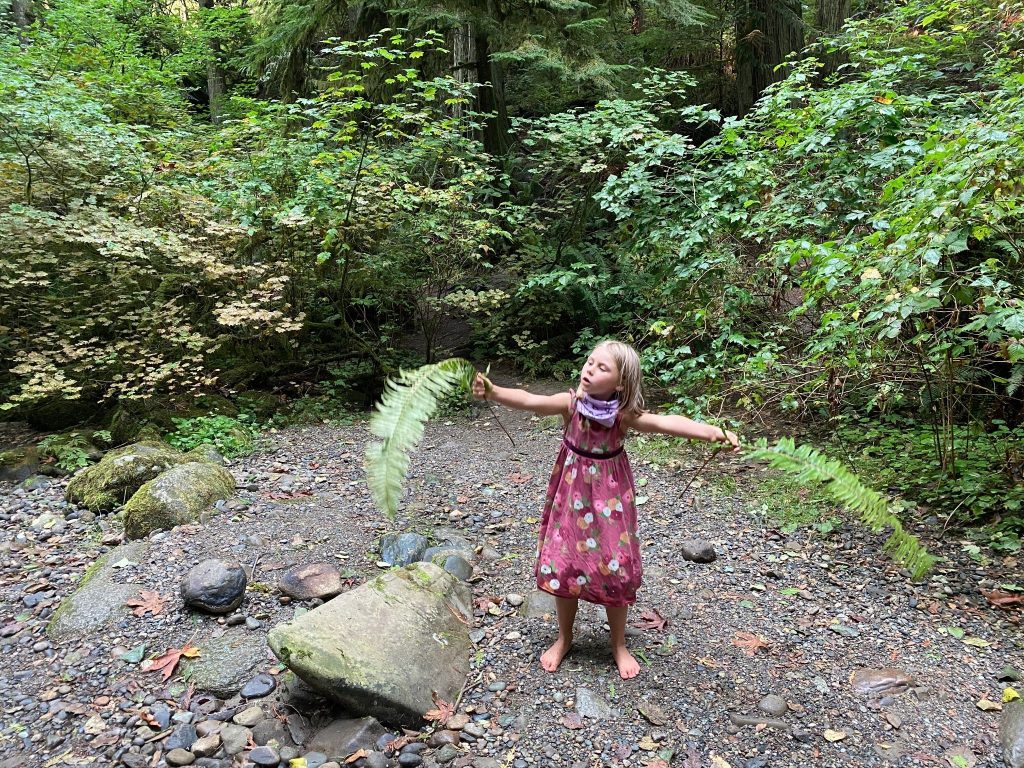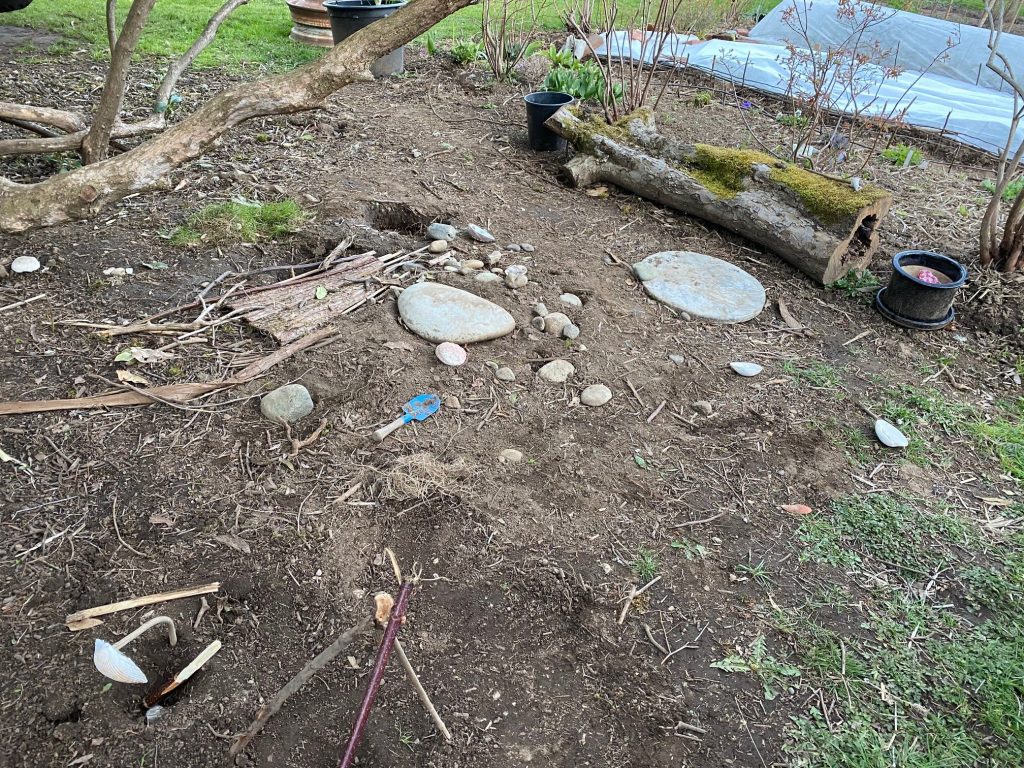Connecting kids with nature is always good

I recently gave a presentation to the Seattle Garden Club about designing children’s gardens, which got me all fired up again about gardening with kids. I’ve had jobs and volunteered in children’s gardens but now I garden with my own kid, so while my presentation prep felt like revisiting a familiar passion, it also spurred some reflections that I wouldn’t have had when I grew market veg with homeless teens as a 24-year-old or when I wrote about eco-literacy for my graduate thesis.
Any time spent letting kids muck around and make discoveries is worthwhile, especially outdoors.
Growing food with kids does feel essential for encouraging healthy eating, building awareness (of many things) and exposing them to the miraculous science and lore of the plant world. But I also believe that like many things parenting and otherwise, memorable experiences are derived as much from us letting go as from skillful design or instruction. Because I am a gardener, I’ll go ahead and call it “gardening” with kids (with nice, bold quotation marks) but truly, any time spent letting kids muck around and make discoveries is worthwhile, especially outdoors.
There are developmental benefits of using malleable materials, “loose parts” and sensory-rich elements like soil and plants, all while relaxing their eyes to a wide-angle focus where they can perceive and observe patterns and relationships in a micro-ecosystem. It gets profound pretty fast. The rewards are many and bundled.

Intending to round out my slideshow of alluring paths, fuzzy plants and bean teepees, I photographed my daughter’s special spot for some real-time, children’s gardening in action. Then I hesitated to include it because there is not a shred of green plant life there, but the more I thought about it the more I realized it might be the most important photo because it shows a place where she and her friends are allowed to reign as supreme architects. It is a packed dirt area under a huge Rhododendron tree where I removed ivy and holly last year and pruned to reveal some excellent “horsey branches” and sculptural trunks. It looks naked next to my garden rows where I aspire to cover every bare inch of soil with lush growth, but it is well-loved. I deposit little offerings of sticks, shells, sod chunks, rocks, and cuttings from the garden for the kids to find and use, and they dig worm houses, construct fairy dens and enact elaborate disaster or infrastructure building scenarios.
I deposit little offerings of sticks, shells, sod chunks, rocks, and cuttings from the garden for the kids to find and use, and they dig worm houses, construct fairy dens and enact elaborate disaster or infrastructure building scenarios.
I’m usually right there in my garden, pointing out little wonders as I come across them, and ready to hear what they notice as they dig. But unless I’m offering something tasty, they prefer their dirt patch where they are masters of their own universe, at ease to step anywhere without being cautioned. They take breaks to munch on the over-wintered kale, visit the chickens or hang on the multiple swings hanging from the massive hawthorn tree that leans over part of the rhody. We just discovered that new hawthorn leaves are tasty, and so last week there were three kids tasting handfuls up in the branches.
I became a gardener by osmosis, and I continue to garden because it allows me to experiment, blow off steam, challenge and apply my own knowledge, and feel present in my body and in the seasons. I already know my daughter has absorbed so much, but I mostly hope she finds similar pleasure, inspiration and release for herself in any activity — not necessarily gardening, although maybe someday she will think (like I do), “I have always gardened.” A person feels most invested in something that they achieve or discover at their own pace and of their own will. Recognizing this can help us to support and engage children, without forcing the issue.

“She has a special lounge area in there where she likes to draw while I seed.”
My mother’s beautiful, productive garden gave me mixed emotions as a kid and I resented it as much as I enjoyed its rewards, because of its ability to swallow her up for hours at a time. I remember giving up yelling and going up the hill to find her, head down, absorbed and inaccessible (frantically trying to accomplish something — I know the feeling now) in the vegetable garden. One season she helped me and my sister dig our own areas in a new corner of her big garden and it held my attention for a surprisingly short time; gardening there all of a sudden felt like a chore rather than a privilege. The soil was not as rich and my flowers didn’t grow as quickly as her veggies, then the wildflowers took over, I realized how much work it was, and I lost interest. Now she has designated a section of garden row as a “demolition derby” and “archaeology dig” for my nephew, right in the middle of things –an instinctive, wise grandma switch that includes him in the big garden but allows him to just excavate/destroy/investigate, which seems to stimulate a child’s imagination most in the garden anyway.
Invite them in, let them dig, make water available somehow, designate a pot or the end of a row for them to grow something, and allow a place for them to be messy.
So this is my advice for gardening with children: invite them in, let them dig, make water available somehow, designate a pot or the end of a row for them to grow something, and allow a place for them to be messy. Teach them and then trust them to use clippers responsibly, and make sure they have tools that work. Then perhaps most importantly (because of your passionate belief in teaching kids to grow things and the myriad benefits attached): relax and pretend you don’t care. Do recognize that achieving easy co-existence is crucial for adult and children inhabitants of gardens, but your brains are simply not on the same level developmentally or in terms of what you perceive and what typically brings you joy (e.g. growing a garden vs destroying it). One of the best approaches is to plant a tough, low screen around their garden/dirt patch so it really feels like their own space, but it doesn’t look like such a scar in your own green, living garden. Try tall grasses like Miscanthus sinensis, native evergreen huckleberries and salal, or perhaps a stylish homemade lattice fence of twigs like willow, alder, fruit tree prunings, or Osier dogwood whips.
I hope you’re out enjoying the gorgeous weather. This is strong sun! Time to plant more peas and lettuce, visit plant sales and break out the frost-tender seeds now. Add compost and mulch if you haven’t already, and see if you can find a place for some native plants in your landscape. Look for bees and other pollinators!
